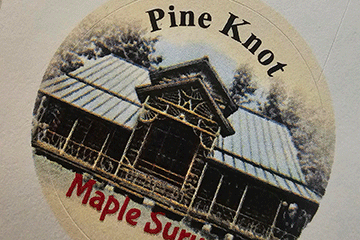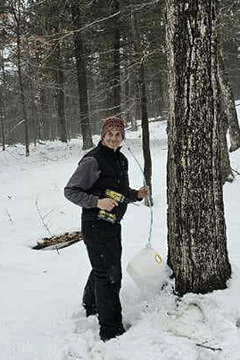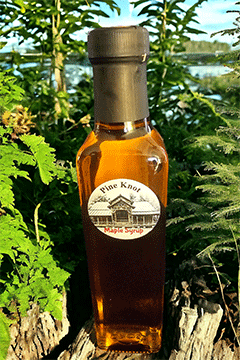
04/02/2024
After more than 100 years, maple syrup is once again being tapped to sweeten campers’ breakfast at the William H. Parks Family Center for Environmental and Outdoor Education’s Camp Huntington on Raquette Lake.
John Donovan and Philip Mosher — caretakers at the W. H. Parks Family Education Center’s Camp Huntington and Antlers campuses, respectively — restarted an Adirondack tradition this winter by inserting a total of 40 taps into stately maples along a footpath of the original Long Point Road leading out to Raquette Lake.
Sap from their first 10 taps from Jan. 29 to Feb. 29 yielded the first gallon of finished product since circa 1900, nearly 50 years before SUNY Cortland acquired the property in 1948.

According to Donovan, he and Mosher had collected 287 gallons of tree sap and produced six gallons of finished maple syrup as of late March.
“The game plan for now is that’s just going to be for alumni,” Donovan said. “My end goal is to have enough product in our store for alumni camps on both sides, Huntington and Antlers, to have it. So, funding is always welcome.”
Before SUNY Cortland acquired the property in 1948 from the family of the late Collis P. Huntington, Camp Pine Knot had remained unused since 1900, according to Cortland College: An Illustrated History, by emeritus History Professor and Honorary SUNY Cortland Alum Leonard F. Ralston.
Like many Adirondack great camps around the turn of the last century, Pine Knot had operated a working farm.
“There would have been a caretaker on property,” said Donovan, who began at Camp Huntington four years ago. “We were doing what the caretaker would have done at any time during the spring to provide syrup for the guests that were there.”
After this year's initial, 10-tap harvest, they set up 30 more trees with blue tubing funneling sap into plastic jugs along the Long Point Road footpath leading out to Raquette Lake.
“We believe we’ve found scars from previous taps done years and years ago,” Donovan said.
Having tried backyard maple sugaring in the Thousand Islands region as a child, Donovan said it was always in the back of his mind to run a sugar bush — a maple syrup orchard — at Camp Huntington.
“The warm temperatures this year got them researching and excited about giving it a go,” said Rhonda Pitoniak ’01, M ’16, outdoor education director.

“The temperature difference between where we’re at up at Huntington and at Cortland is about two weeks behind (Cortland) in the spring and two weeks ahead in the fall,” Donovan said.
Donovan printed out and studied the Cornell Maple Program process literature.
“Then I found that Phil was going to be on our side of the lake for the winter,” Mosher’s first with SUNY Cortland, Donovan said. “He’s been my righthand guy.”
Depending on the warm and cold temperature fluctuations, either Donovan or Mosher made the daily 15-minute sap collection circuit on a winterized all-terrain vehicle, pouring the trees’ liquid yield into a 30-gallon collection tank in back.
With their own money, the caretakers bought a reverse osmosis system that removes water and concentrates the syrup by 50%, bringing 40 gallons of maple sap halfway to the goal of yielding a single gallon of syrup. A well-fed boiler completes the process.
“The rest of the equipment, I purchased myself, which is being donated to Cortland,” Donovan said. That included an evaporator, which was mounted atop an old fuel tank they had cleaned out, cut up and fashioned into their firewood-fueled maple syrup cooker.
“We’re trying to reuse stuff that’s kicking around,” Donovan said of the hybrid sap cooker.
Once boiled down to liquid gold, they processed and bottled the results of the small first harvest of two cases of syrup in 36 bottles in 5 oz. or 8.5 oz. jars. Donovan repurposed a graphic designed for a 2004 ceremony when Camp Huntington was designated a National Historic Landmark.
“I’m hoping this could go for fundraisers, maybe auctions,” Donovan said. “From what we’re producing up here, maybe we can give back to the university a little more.”
Any monies raised will go toward the facility’s Historic Preservation fund, Pitoniak said. The Cortland College Foundation established the fund to help restore and maintain Camp Huntington’s original historic structures.
Now Donovan and Mosher are eyeing a dilapidated original camp barn as a sugar shack.
“Next year, we hopefully can do something more along the lines of running tubes so it will take us less time to collect,” said Donovan, describing a set-up-and-leave modern method of sap collection. “Hopefully we’ll do that in the future because we do want to tap a few more trees. Along our low ropes course, we have 80 trees we can tap, and that’s just a small portion of the property.”
During one late February weekend, Donovan, Mosher and Pitoniak demonstrated maple sugaring with a class on indigenous living from Syracuse University.
“They each got a jug. We had the old-fashioned hand drill plus we had today’s technology,” said Donovan. “So, they were hand drilling the holes in the trees. Then they were able to put the taps in the trees, which was a great experience.”